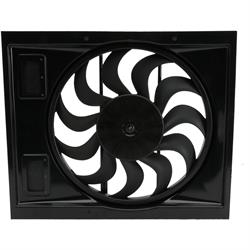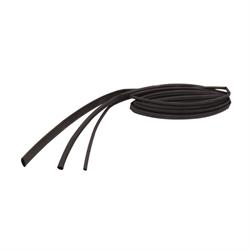Electric Radiator Cooling Fan Guide
There are several factors to take into account when selecting an electric fan for your project. This guide will help you understand the differences in fans that are available and assist you with choosing related products that will be necessary to complete the installation.
Mechanical vs Electric Fan
Electric fans have many advantages over mechanical fans. Racers and hot rodders love electric fans since they free up power that would otherwise be robbed by the effort needed to turn a mechanical fan. Add in the fact that an electric fan can be turned on and off so that it is only running when needed as well as the thin streamlined profile and the choice is obviously in favor of an electric fan. It’s no secret that OEM’s have been using them for years and for good reason. Efficiency, performance, and reliability of electric fans have come a long way in recent history while mechanical fans have somewhat faded away in most passenger vehicle applications.
Puller vs Pusher Fan
Puller fans are mounted on the engine side of the radiator and do just that, they pull air through the radiator. Pull type fans are the most popular and for good reason, they are more efficient and flow more air than a comparable pusher fan. Push type fans are mounted on the front side of the radiator and push air through the radiator. Not only are less efficient at moving air they also inhibit the free flow of air into the radiator coming through the vehicles grill at highway speeds. If your application simply has no room between the radiator and the engine a push style fan may be your only option. Another common application for pusher fans would be using one in conjunction with a mechanical fan. It is very common for older vehicles with marginal cooling systems to have overheating issues at low vehicle speeds, stop and go traffic, or parades. Adding a pusher fan to assist with moving air across the fins of the radiator in these situations is many times the best option due to the simplicity and low cost compared to upgrading the entire cooling system.
Single vs Dual Fans
Some radiator sizes are large enough to be able to use two electric fans instead of one. This can be advantageous for some applications but be careful when selecting your fans for a dual fan setup. In some cases the fans have to be so small for a dual setup that a larger single fan would flow more CFM of air and potentially cool better. Some radiator sizes are large enough to allow dual 12” fans to be used however and there are several high flow options in that size that do an excellent job of cooling. A dual fan system such as 9174004 for example flows 2,090 cfm and at just under 3 inches thick, they are ideal for tight space applications. When a dual fan system is utilized you have the option to turn each fan on independently. When wired up with two different temperature ranges you will ease the load on the charging system as well as reduce fan noise since much of the time one fan is sufficient to keep the coolant temperature in check.
What CFM Electric Fan Do I Need?
This is a question we get often and unfortunately one that is incredibly hard to answer. First though CFM stands for cubic feet per minute. It is a measurement of air flow and the higher the CFM rating on a fan the more air it will move. More air flow across the radiator equates to more cooling capability and when dealing with a cooling system it’s better to have too much than not enough. Each application is a little different and there are a long list of factors that contribute to a properly functioning cooling system. The simple and most effective solution is to error on the higher side of CFM ratings. The only downside to choosing a fan that is overkill for you application is that it will be a little louder when running as compared to a similar fan with a lower CFM rating.
Two Speed Fans
Some fans have a two-speed fan motor which allows the fan to run on low speed until the coolant temperature rises to the threshold that you want the fan to run at high speed. This is advantageous for both noise and electrical draw. A two speed fan running at low speed can hardly be noticed over the sound of the engine idling and is especially desirable for street driven applications. Two speed fans will require two relays and two temperature sending units if you want to take advantage of the two speed operation. These fans can also be wired to simply run on high speed with a single relay if the two speed operation is not necessary for your application.
Curved Blade vs Straight Blade Fans
The two most common fan blade configurations are curved blade and straight blade designs. A curved blade fan is generally quieter than a straight blade. Straight blade fans typically flow more air if all other factors are equal such as fan size, motor size, fan shroud, etc. Both fan designs work well and there isn’t an overwhelming winner or loser here. It is something to keep in mind however if the sound level of the fan is important to you.
Brushless Fans
Brushless fans such as 13332SP480 by DeWitt’s are one of the newest technologies to come to the electric cooling fan market. The electric motor which powers the fan does not have brushes hence the name brushless. These fans are extremely efficient and consume much less wattage to achieve the same airflow as compared to a standard brushed version. Couple that with the ability to use a pulse width modulated (PWM) fan controller and you will have some of the most modern cooling system technology available.
Relays and Fan Controllers
Once you have your fan chosen you will need some way to power it. As a minimum a relay will be required to operate an electric fan since the amperage draw can easily exceed the capacity of most ignition switches. Be sure to select a relay with the proper amperage rating to meet the needs of your fan. A 40 amp relay is common for use with many electric fans but some high flow fans will require a 70 amp relay.
The simplest method of wiring an electric fan is to use a relay that is switched on and off by the ignition switch. This method works well to cool the vehicle but the drawback is the fan will be running constantly when the ignition is on. Fan noise and added electrical system load will be present at all times.
A better option for wiring an electric fan and keep it simple is to add a thermostatic switch which reads the coolant temperature and switches the fan on and off as necessary. This is an extremely popular option due to the low cost and simplicity of the system. Many electric fan wiring kits are available such as 2897108 which includes the temp sensor, relay, and fuse holder. The coolant temperature at which the fan will be turned on or off depends upon the sensor used. There is no adjustment using this system, but the sensor can be changed to a different temperature rating if desired.
The next step up is an adjustable fan controller. Several options are available such as our Radiator Cooling Fan Control Module for Mechanical Gauges 91064024 which allow for adjustment of the coolant temperature at which the fan will run. This is a great choice for many applications since all that is necessary to adjust the temperature setting is to turn a knob. No need to break the cooling system open and spilling coolant all over that beautifully detailed engine. With temperature adjustment being so easy this works well for vehicles that see some track time. You can adjust your temperature lower for the track to maximize power, then raise it back up while cruising the streets for maximum efficiency.
Pulse width modulated fan controllers (PWM) are latest technology to come to electric fan control. These will control the amount of power that is supplied to your fan and allow it to run at variable speeds. All other controllers simply turn the fan on or off and when the fan is on it will be running at full speed. With a PWM fan controller such as 910Z18350 it will send only the amount of power necessary to maintain the set temperature. This further reduces electrical system load and keeps fan noise to a minimum. Another great feature of PWM controllers is the soft start feature. This will start the fan slowly and then ramp up the power as necessary so that an instant surge of power draw is eliminated.
Electric Fan Shrouds
Just like with mechanical fans a fan shroud is an excellent addition to get the most out of your electric fan. A shroud will allow the fan to pull air through a larger area of the radiator core thus increasing cooling system performance. Many incorporate rubber flaps that will be closed while parked or at low vehicle speeds and open at higher vehicle speeds to allow free flowing air to be pushed through the opening. Other benefits of a shroud are that it is an excellent mounting structure for the fan and they deliver a professional appearance. Fan shrouds should always be used on the engine side of the radiator along with pull style fans. If a fan shroud is used in front of the radiator with a pusher fan it will block the free flowing air coming through the grille of the vehicle at higher speeds and almost certainly cause overheating issues.
Trinary Switch
A trinary switch is a must have item when installing an electric fan on a vehicle that has air conditioning. This switch senses pressure in the air conditioning system and will turn the electric fan on any time the A/C is being used. This aids in air conditioning system performance by pulling more air across the condenser which is mounted in front of the radiator. It is especially helpful at low vehicle speeds, stop and go driving, and when parked or idling.
Wiring Components
A professional installation can be easily achieved but you will need the right products first. A variety of wiring essentials are available to complete your electric fan installation. Primary wire, heat shrink tubing, grommets, and wire conduit are some of the basics that will be required. Don’t get caught with half the supplies needed for your installation and then scrambling to find what you need. We offer a wide variety of products to bring your project to completion. Take your time and plan your wire routing carefully and you will be amazed at the finished result.











